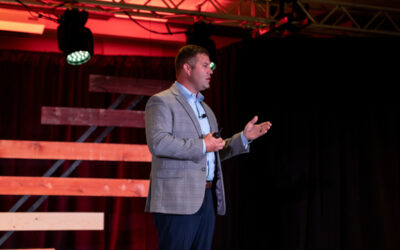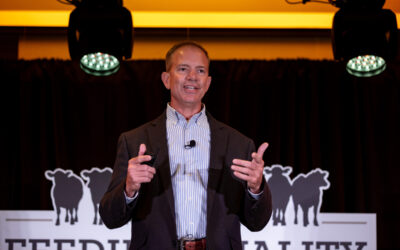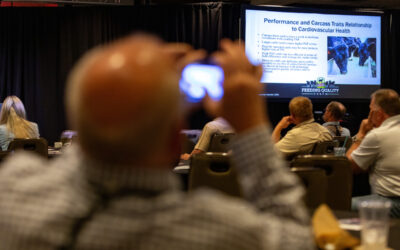
Cows that fit, calves that fit
Moser talks genetic optimums at Feeding Quality Forum
By Miranda Reiman
Genetic selection for ranch environment or meeting market demand?
That’s a choice cattlemen don’t have to make, said Dan Moser, president of Angus Genetics Inc., speaking at the Feeding Quality Forum in Sioux City, Iowa, this summer.
“It is not an either/or thing. It’s selection for ranch environment while meeting market demand,” he said. “There are Angus cattle that will certainly do well for the combination of traits that are favorable for carcass merit, yet they are still efficient in the cow herd. They are fertile; they have longevity.”
You need to take into account all the genetic information that will help get the cows and calves you want, but those target endpoints probably aren’t the same as they were even a decade ago.
Moser said the ideal cow has changed over the years because the markets have changed.
“There was a time where all calves that were the same color and the same weight brought the same amount,” he said. “Now we are seeing more emphasis on sort of specification feeder cattle and documenting those differences.”
Heavier carcasses bring more dollars, which is why average steer carcass weights have increased 112 pounds (lb.) since 1996. USDA-reported carcass weights for mature cows (including dairy) jumped 119 lb. during that same time, but the Angus expected progeny differences (EPDs) for yearling weight are increasing faster than those for mature weight.
Is there a way to make those trend lines diverge completely?
“The idea of finding that balance doesn’t mean we don’t improve them both simultaneously,” Moser said, citing the birth- versus yearling-weight example. “There was a time when it was thought that we couldn’t simultaneously improve both of those, but we have done that.”
Quality grade trends are another example of dramatic progress. Marbling EPDs were just above .2 in 1986, and today sit just below .6. In a decade’s time, the number of Certified Angus Beef ® (CAB®)-brand qualifying cattle doubled, from near 2.25 million in 2007 to 4.5 million in 2017 and more than 5 million in 2018.
“We didn’t look at that one and say, ‘He looks like he’s high marbling, and so we’re going to breed him,’” Moser said. “We have to do the same thing with maternal factors. We can overcome any antagonism if we have the data, but we can’t eyeball it.”
Breeders who are submitting data to the American Angus Association’s Maternal Plus program will spur tool development.

“Honestly, our data across the entire beef industry on things like fertility, cow longevity—it’s limited,” he said. “We’re going to have to be dedicated to objective data collection for those traits to make sure that we can have the meaningful tools we need to drive things forward.”
Genomic testing speeds progress, too, allowing accurate predictions on younger animals and helping “make lower risk selection decisions,” Moser said.
He’s also hopeful it can help address region-specific challenges by creating EPDs for everything from hair shedding and foot structure to cow longevity and altitude tolerance.
“You’ll be able to really tailor genetics to fit your environment,” he said.
Cows that breed back and produce quality calves buyers back—Moser said the day has arrived when nobody has to choose between the cow herd or the consumer.
The forum was presented by the Certified Angus Beef ® (CAB®) brand, with cosponsors Where Food Comes From, Roto-Mix, Feedlot Magazine, Tyson Foods, Intellibond, Zoetis and Diamond V.
you may also like
Consumer Demand, Power of Quality
Demand for high-quality beef persists. But with that demand comes challenges. From tight cattle supplies to higher costs and increasing pressure on retailers to deliver a consistent eating experience, the pressure is on. David O’Diam, CAB VP of retail, addressed the current retail beef environment, highlighting both opportunities and challenges in today’s marketplace.
Data-Driven Progress and Partnerships
Discussions at Feeding Quality Forum reaffirmed the industry’s commitment to quality, transparency and innovation. With record Prime rates and strong consumer demand, producers who invest in genetics, health and relationships are positioned to drive progress and capture premiums.
Better Cattle Bring Opportunity
Cattle keep getting better, but that doesn’t mean producers should slow down progress. That’s what attendees took home from the 2025 Feeding Quality Forum. It’s call to action for the entire beef industry. Better cattle, yet new and old challenges for each segment.



